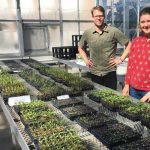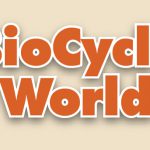BioCycle February 2019
Blueprints To Catalyze Organics Recycling
The theme of BioCycle’s 32nd Annual West Coast Conference (BioCycle WEST COAST19), April 1-4, 2019 in Portland, Oregon, is Catalyzing Organics Recycling. Attendees will amass knowledge and tools to create blueprints to keep organics out of landfills and divert them to their highest and best end uses — starting with developing and/or fine-tuning programs to capture and utilize edible food currently in the waste stream. Highlights on the program at BioCycle WEST COAST19 include:
• Two workshops: Renewable Natural Gas — The Bottom Line, which provides biogas producers a road map to tap opportunities and break down barriers; and Foundations of Composting, covering basic principles of composting, monitoring and managing the process, composting methods and compost markets.
• Opening Plenary Think Tank kicks off the Conference on April 2, featuring Stephen Jones, Director of The Bread Lab, Ned Foley, owner of Two Particular Acres, and Sally Brown of the University of Washington. They will weave together the critical connections between organics recycling, sustainable food production and healthy and resilient soils.
• Table Talks during Conference sessions on April 2-3, using a format that starts with “state of the knowledge” presentations followed by interactive discussions. Table Talk topics include: Behavior Change Strategies To Catalyze Organics Recycling; Advancing Renewable Natural Gas Deployment; Managing Organics In The PFAS Age; and Compostable Food Service Packaging.
• Facility Tours on April 4 to Stahlbush Island Farms, which grows and quick freezes fruits, vegetables and legumes, anaerobically digests the residuals, and utilizes biogas to power and heat operations and the digestate to fertilize its crops; and Rexius Eugene, a commercial composting facility processing yard trimmings and food waste into high value compost products.
Climate Solutions Act Of 2019
On Jan. 9, 2019, Rep. Jimmy Gomez (CA-34) and Rep. Ted Lieu (CA-33) announced the introduction of the Climate Solutions Act of 2019. Drafted in response to the growing threat posed by climate change, the bill establishes a National Renewable Energy Standard to drive the United States towards 100 percent renewable energy by 2035. It also creates a National Energy Efficiency Standard to reduce energy usage from electric retailers and sets strict greenhouse gas emissions targets to reduce emissions to 80 percent below 1990 levels by 2050. Stated Rep. Gomez: “As one of the defining issues of our time, the global threat of climate change demands an audacious response, and that’s precisely what Rep. Ted Lieu and I introduced today.”
California’s SB1383 Regulations Open For Comment
In September 2016, Governor Jerry Brown signed into law SB 1383, establishing methane emissions reduction targets in a statewide effort to reduce emissions of short-lived climate pollutants (SLCP) in various sectors of California’s economy. The new law codified the California Air Resources Board’s Short-Lived Climate Pollutant Strategy to achieve reductions in the statewide emissions of SLCP. SB 1383 established targets to achieve a 50 percent reduction in the level of the statewide disposal of organic waste from the 2014 level by 2020, and a 75 percent reduction by 2025. The law gave the California Department of Resources Recycling and Recovery (CalRecycle) the regulatory authority required to achieve the organic waste disposal reduction targets, and establishes an additional target that not less than 20 percent of edible food that is currently disposed of is recovered for human consumption by 2025.
On January 18, 2019, CalRecycle’s proposed SB 1383 regulations were officially noticed by the Office of Administrative Law. The 45-day public comment period closes March 4, 2019. “The regulations are expected to be adopted in 2019 and become effective in 2022,” notes the California Compost Coalition, “sending regulatory signals to local government, generators, and the recycling industry to start planning to divert over 15 million new tons [of organic waste] by 2025 and adding 80 to 90 new composting and anaerobic digestion facilities. … Adopting regulations in 2019 allows regulated entities approximately three years to plan and implement necessary budgetary, contractual, and other programmatic changes. Jurisdictions, haulers, and generators should consider taking actions now to implement programs to be in compliance with the regulations on January 1, 2022.”
Vermont’s Act 148 Food Scraps Ban Update
In its Biennial Report On Solid Waste (Report) submitted to the Vermont legislature on Jan. 15, 2019, the state Department of Environmental Conservation (part of the Agency of Natural Resources) notes that even with strides made in recycling, food donation, and composting, 11 percent more Vermont materials went to the trash in 2017 than in 2016. This reversed decreasing disposal trends seen in 2015 and 2016. Vermont’s most recent draft 2018 Waste Composition study shows a similar percentage of food waste in the waste stream compared with the 2013 study.
The Report updates the Vermont legislature about implementation of the Universal Recycling Law passed in 2012 (known as Act 148) that banned disposal of recyclables into landfills starting in 2015. Food scraps will be banned from landfills starting in 2020. The 2018 waste characterization study findings “reinforces DEC’s support for maintaining the July 1, 2020 ban on food scraps in order to meet long-standing state diversion goals,” states the agency in the Report. “Further, the premise behind the Universal Recycling law’s food scraps disposal ban is to provide assurance to those who are willing to invest, that food and food scrap material will be available for processing.”
The original Act 148 also requires haulers to provide curbside collection of food scraps to all households in the state by July 2020. But in May 2018, the legislature passed S.285 that directed DEC to conduct a study to evaluate if changes to that requirement were needed in the Universal Recycling law. As a result of that study, DEC recommends in the Report that the legislature amend the Universal Recycling law to exempt all haulers from collecting food scraps from single family residences and multi-residential units of less than 4 units — but maintain the hauler requirement by only requiring haulers to offer collection of food scraps to their commercial customers and multi-residential (4 or more units) customers, unless they can demonstrate another hauler is providing such collection services in that area. During the study, haulers made the case that they would not be able to get enough density on residential collection routes to make the service economically viable. The state’s 108 transfer stations are complying with requirements (effective July 2017) to offer food waste drop-off service for households.
On the processing infrastructure side, ANR believes it will need up to 46,000 tons of new depackaging, composting and anaerobic digestion capacity by 2020, and is offering state grants to help with those investments.
Growing Piles Of Human And Animal Waste
In a paper published in November 2018 in Nature Sustainability, a research team from Georgia Institute of Technology and the Centers for Disease Control and Prevention put forth what they believe is the first global estimate of annual recoverable human and animal fecal biomass. In 2014, the most recent year with data, there were 4.3 billion tons of fecal biomass and growing; waste from livestock outweighed that from humans 5:1 at the country-specific human and animal population estimates. From 2003 to 2014, the amount of waste biomatter produced grew annually by more than 57 million tons as both human and livestock populations grew. The researchers estimated that by 2030, the total amount of global fecal biomass produced each year would reach at least five billion tons, with projections of livestock waste outweighing that from humans by a ratio of 6:1. The study combined global animal population data from the United Nations, human population data from the World Bank as well as earlier research on animal-specific estimates of fecal production.
Metals, phosphorus, nitrogen and potassium are all among the resources that could be recovered from human and animal waste. The researchers pointed to an earlier analysis that estimated the value of recoverable metals alone reaches $13 million a year from the waste of one million people. They estimated that by 2030, the planet’s total annual fecal and urinary biomass could contain as much as 100 million tons of phosphorus, 30 million tons of potassium, 18 million tons of calcium, and 5.5 million tons of magnesium.
While chickens were the most plentiful livestock globally, cattle, with their larger body mass, produced the most fecal waste on the planet. As a result, countries with high numbers of cattle, such as those in the Americas, produced the most waste by mass.










